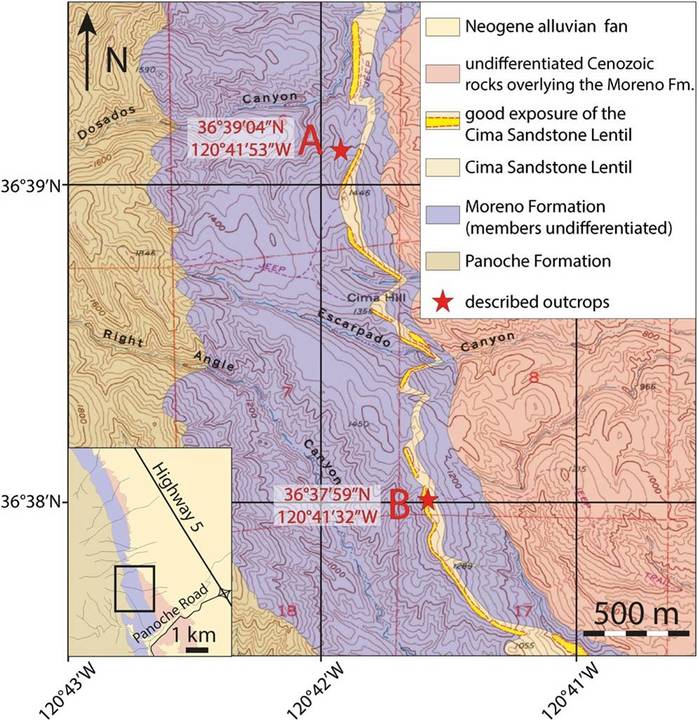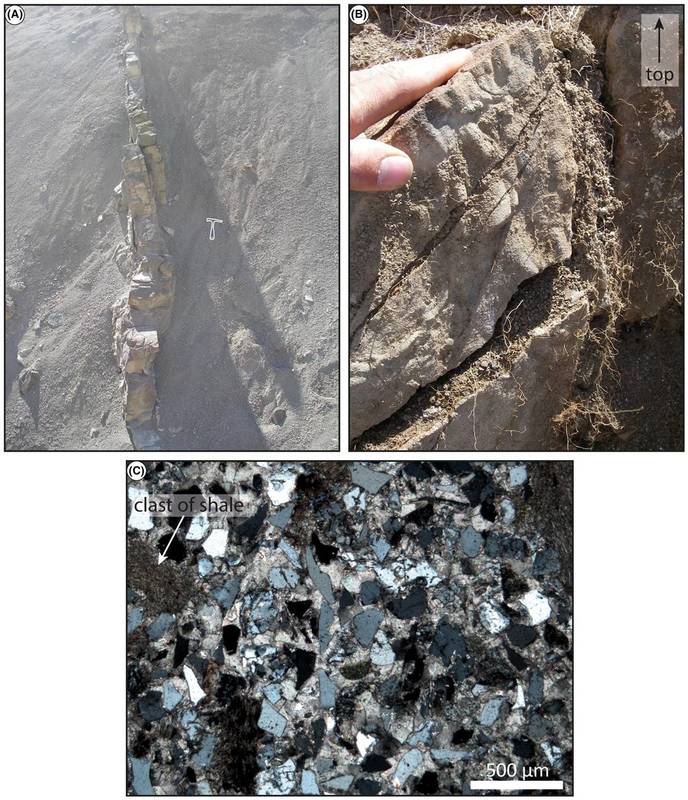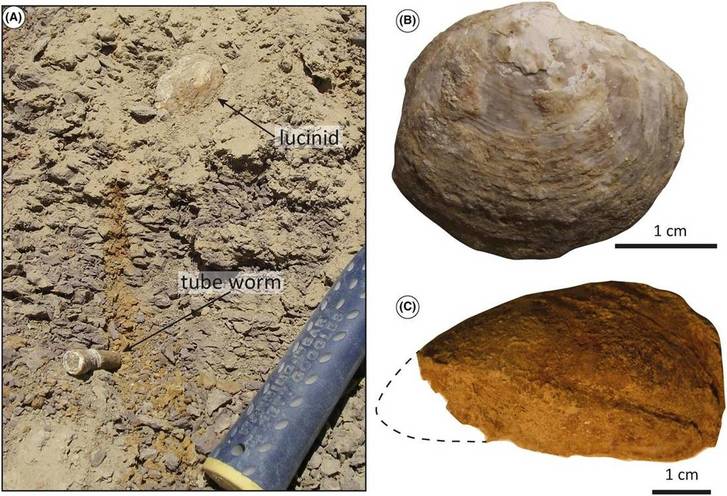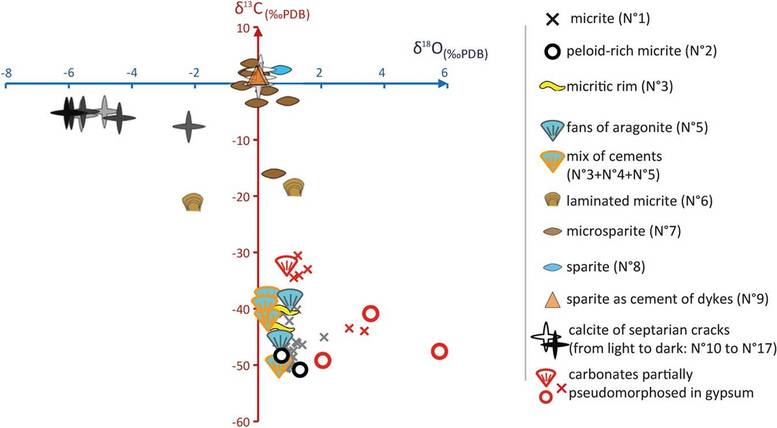
Mechanisms of biogenic gas migration revealed by seep carbonate paragenesis, Panoche Hills, California
Leaded author: Jean-Philippe Blouet
Copyright ©2016. The American Association of Petroleum Geologists. All rights reserved. Gold Open
Access. This paper is published under the terms of the CC-BY license.
Manuscript received February 16, 2016; provisional acceptance February 16, 2016; revised manuscript
received August 5, 2016; fi nal acceptance October 17, 2016.
DOI:10.1306/10171616021
Abstract
A comprehensive study of seep carbonates at the top of the organic-rich Maastrichtian to Danian Moreno Formation in the Panoche Hills (California) reveals the mechanisms of generation, expulsion, and migration of biogenic methane that fed the seeps. Two selected outcrops show that seep carbonates developed at the tip of sand dykes intrude up into the Moreno Formation from deeper sandbodies. Precipitation of methane-derived cements occurred in a succession of up to 10 repeated elementary sequences, each starting with a corrosion surface followed by dendritic carbonates, botryoidal aragonite, aragonite fans, and finally laminated micrite. Each element of the sequence re flects three stages. First, a sudden methane pulse extended up into the oxic zone of the sediments, leading to aerobic oxidation of methane and carbonate dissolution. Second, after consumption of the oxygen, anaerobic oxidation of methane coupled with sulfate reduction triggered carbonate precipitation. Third, progressive diminishment of the methane seepage led to the deepening of the reaction front in the sediment and the lowering of precipitation rates. Carbonate isotopes, with d 13 C as low as -51‰ Peedee belemnite, indicate a biogenic origin for the methane, whereas a one-dimensional basin model suggests that the Moreno Formation was in optimal thermal conditions for bacterial methane generation at the time of seep carbonate precipitation. Methane pulses are interpreted to reflect drainage by successive episodes of sand injection into the gas-generating shale of the Moreno Formation. The seep carbonates of the Panoche Hills can thus be viewed as a record of methane production from a biogenic source rock by multiphase hydraulic fracturing.
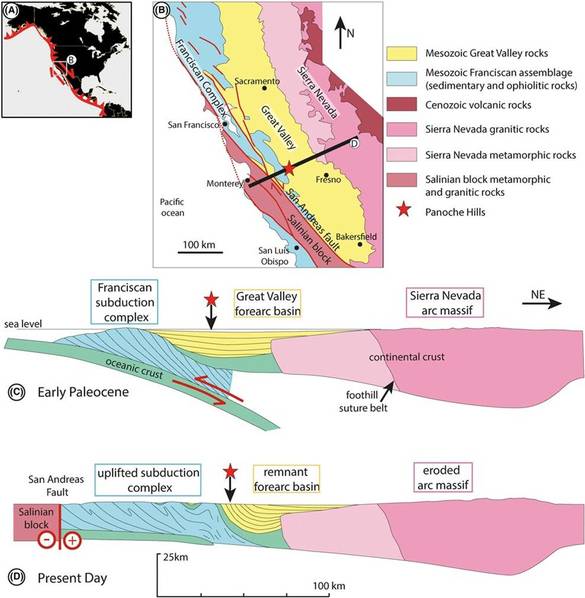
Figure 1. Geodynamic setting
of the Panoche Hills outcrop. (A)
Location of the study area along
the western margin of the North
American continent. (B) Simplified geological map of California.
(C) Schematic cross section of the
western American plate during
the early Paleocene. (D) Recent
geological pro fi le (modi fi ed from
Dickinson and Seely, 1979, with
permission of AAPG).
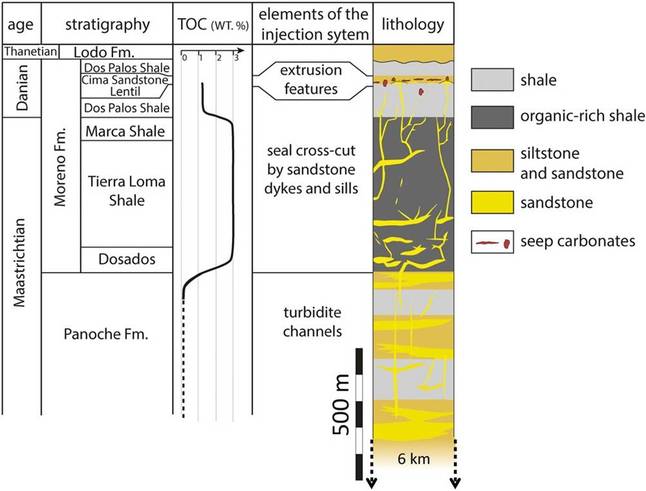
Figure 1. Geodynamic setting
of the Panoche Hills outcrop. (A)
Location of the study area along
the western margin of the North
American continent. (B) Simpli-
fi ed geological map of California.
(C) Schematic cross section of the
western American plate during
the early Paleocene. (D) Recent
geological pro fi le (modi fi ed from
Dickinson and Seely, 1979, with
permission of AAPG).
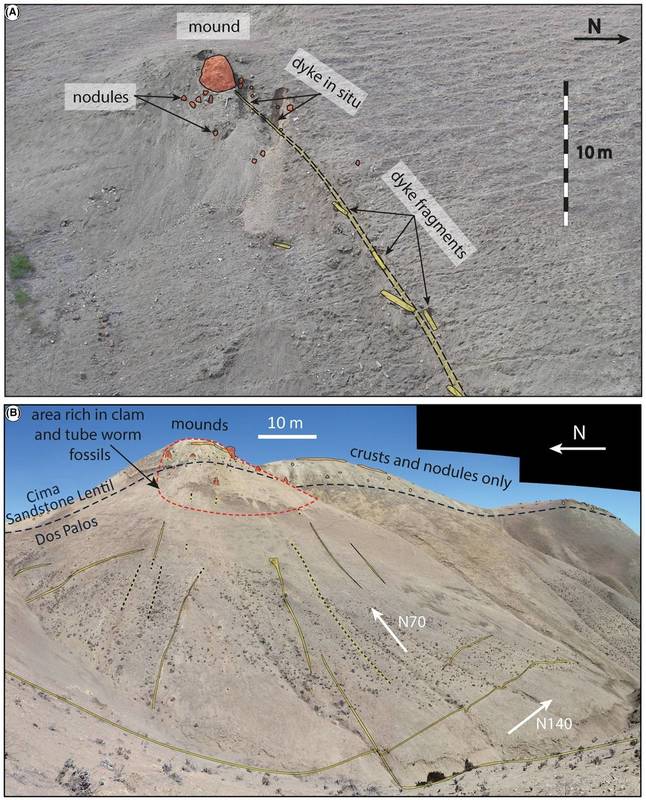
Figure 4. View of the two studied outcrops showing the relationship between dykes and overlying seep carbonates. Observed dykes are
indicated by solid lines, whereas inferred dykes are represented as dotted lines. (A) Outcrop A. The upper part of the dyke is surrounded by
nodules, and its tip is directly capped by a mound. The dyke is observed as fragments, and two excavations show it in situ. (B) Outrcop B:
a cluster of mounds and nodules in the Cima Sandstone Lentil overlying a dyke swarm (directions of the dykes indicated by white arrows).
Away from the dyke swarm, the concretions of the Cima Sandstone Lentil comprise only crusts and nodules.
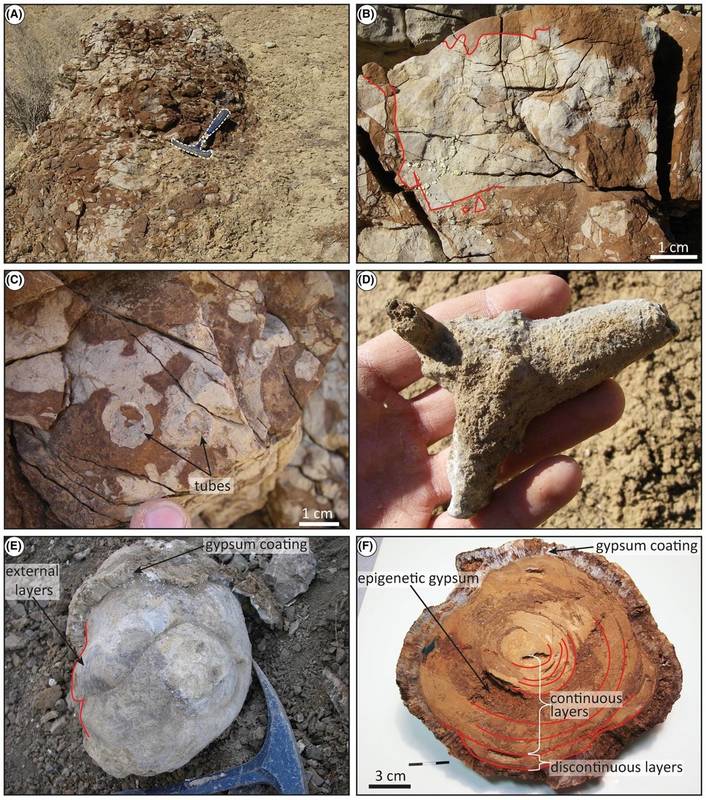
Figure 4. View of the two studied outcrops showing the relationship between dykes and overlying seep carbonates. Observed dykes are
indicated by solid lines, whereas inferred dykes are represented as dotted lines. (A) Outcrop A. The upper part of the dyke is surrounded by
nodules, and its tip is directly capped by a mound. The dyke is observed as fragments, and two excavations show it in situ. (B) Outrcop B:
a cluster of mounds and nodules in the Cima Sandstone Lentil overlying a dyke swarm (directions of the dykes indicated by white arrows).
Away from the dyke swarm, the concretions of the Cima Sandstone Lentil comprise only crusts and nodules.
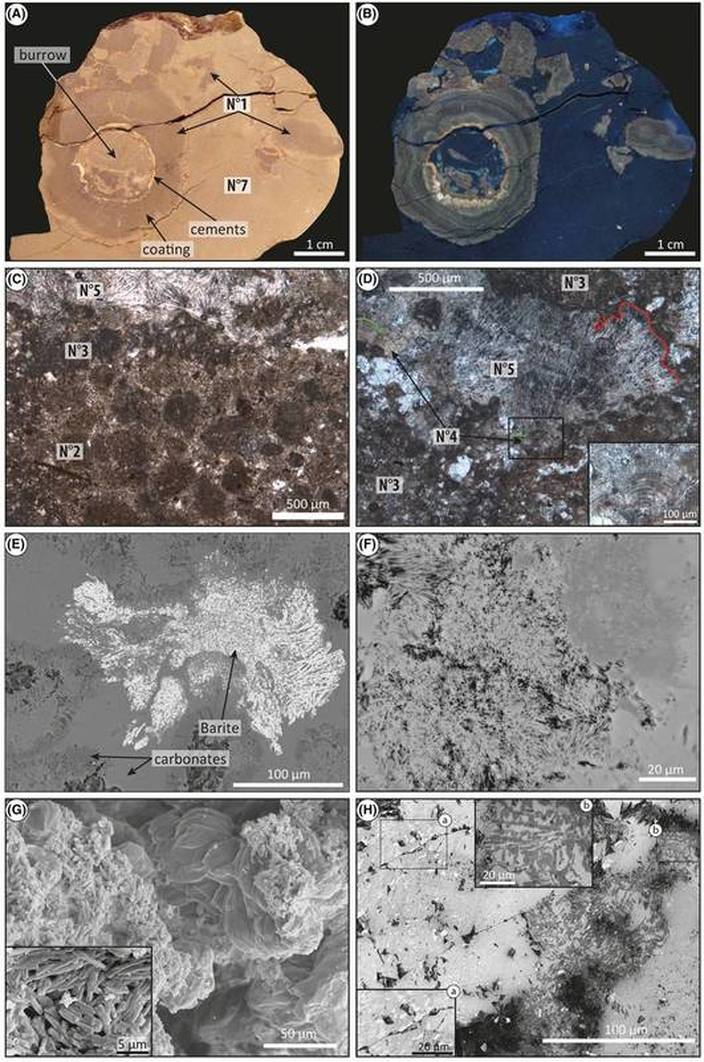
Figure 8. Petrographic features of early diagenetic minerals. (A) Polished slice of a mound sample: gray nodules (micrite N°1) are
embedded within the brown matrix (microsparite N°7). The indicated burrow is coated by micrite (N°1) and lined by cements. (B) View of the
same sample under ultraviolet light. Micrite (N°1) is strongly fluorescent, visualizing concentric rims around the burrow. (C) Peloid-rich micrite
(N°2) covered by a micritic rim (N°3) and aragonite fans (N°5). (D) Typical succession of minerals forming the elementary sequence (ES):
micritic rim (N°3), botryoidal aragonite (N°4), and fans of aragonite (N°5). The upper part of the aragonite fans is corroded (underlined by the
red sinuous line). (E) Backscattered electron–scanning electron microscope (BSE–SEM) picture showing the micritic rim (N°3) composed of
fi brous barite and several carbonate phases. (F) A BSE picture of the micritic rim (N°3) showing fibrous carbonates. (G) An SEM picture showing
the micritic rim (N°3) with subhedral crystals covered by randomly orientated elongated crystals. The insert shows a representative example of
the elongate crystals at a higher magni fi cation. (H) A BSE picture of the micritic rim (N°3). Detail a shows bright (Sr-rich), aligned, elongated
crystals. Detail b shows dark (Mg- and Mn-rich), dendritic crystals. Note: A color version can be seen in the online version.
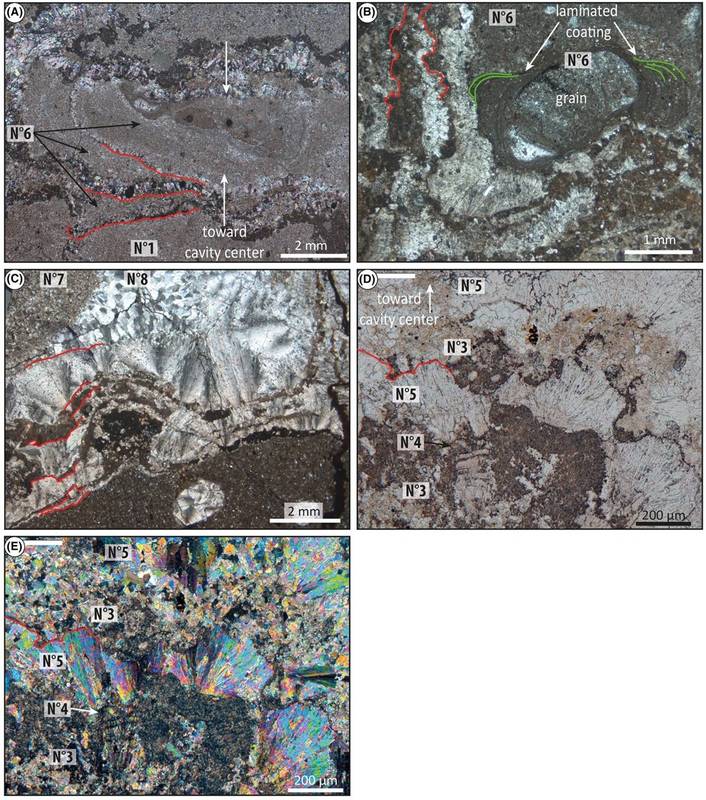
Figure 9. Petrographic features of early diagenetic minerals. (A) Three elementary sequences (ESs) terminating with a layer of laminated
micrite (N°6). The laminated micrite (N°6) of the last sequence occludes the cavity. The base of each ES is highlighted by a red line. (B)
Several ESs terminating with corroded aragonite fans. The last ES ends with a thick cover of laminated micrite (N°6) hosting a coated grain
(green line underlining the lamination). (C) At least six well-developed ESs. The aragonite fans of the last sequence are well developed.
(D) Corroded aragonite fans at the boundary between two ESs. (E) Same picture under crossed nicols. Note: A color version can be seen in
the online version.
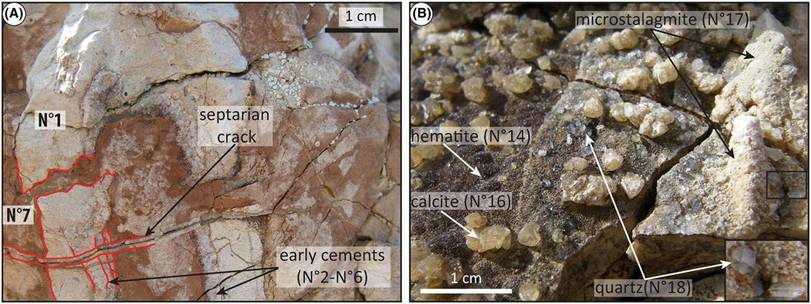
Figure 10. Late diagenetic minerals. (A) Burrow coated by micrite (N°1) and lined by early cements (N°2–N°6). Both have been crosscut
by a crack filled by microsparite (N°7) and later by a septarian crack. (B) Surface of a well-developed septarian crack covered by hematite
(N°14), sparite (N°16), microsparite (N°17) with a microstalagmitic morphology, and euhedral quartz (N°18).
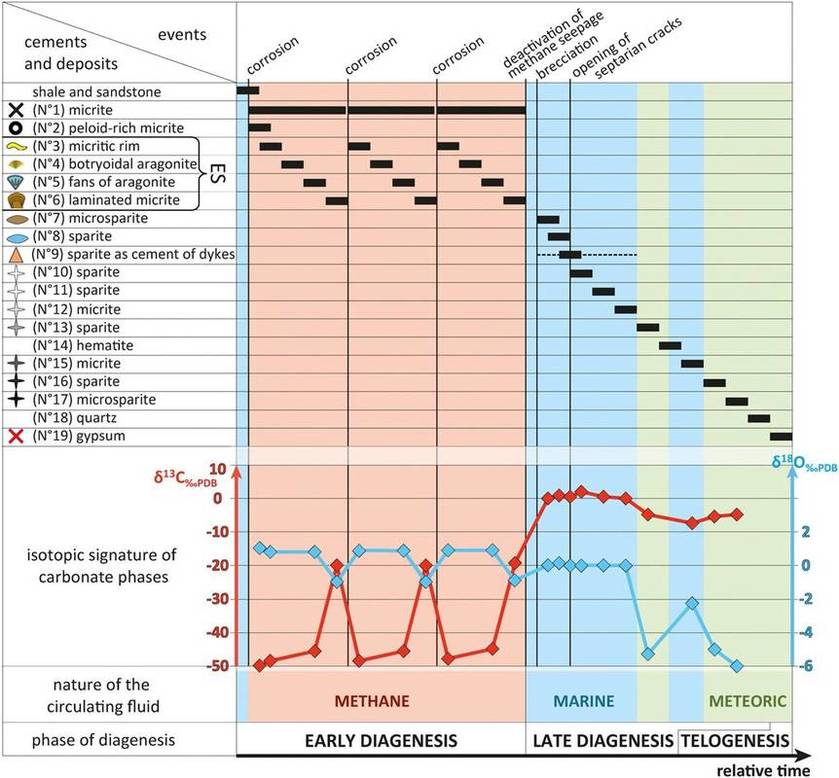
Figure 12. Paragenetic sequence observed in outcrops A and B. In this example, three elementary sequences (ES) are represented. The
average stable isotope signature of each analyzed carbonate phase is indicated. The succession of three types of diagenetic fl uids can be
distinguished: methane, marine, and meteoric waters. Beginning of late diagenesis is marked by the fi rst marine cement; telogenesis
corresponds to the precipitation of gypsum. PDB = Peedee belemnite.
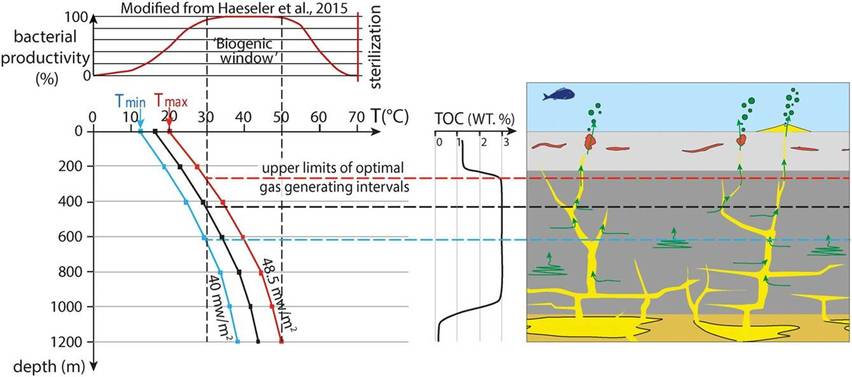
Figure 13. One-dimensional (1-D) thermal model of the Moreno Formation at the time of seep carbonate precipitation. Three cases have
been calculated using the minimum, average, and maximum values of seafloor temperature (T min–T max ) and heat flow taken from literature
(see references in text). The curve of bacterial activity as a function of temperature is from Haeseler et al. (2015). The three upper limits of the
optimal biogenic gas window were calculated at 200, 400, and 600 m below sea fl oor. T = temperature; TOC = total organic carbon.
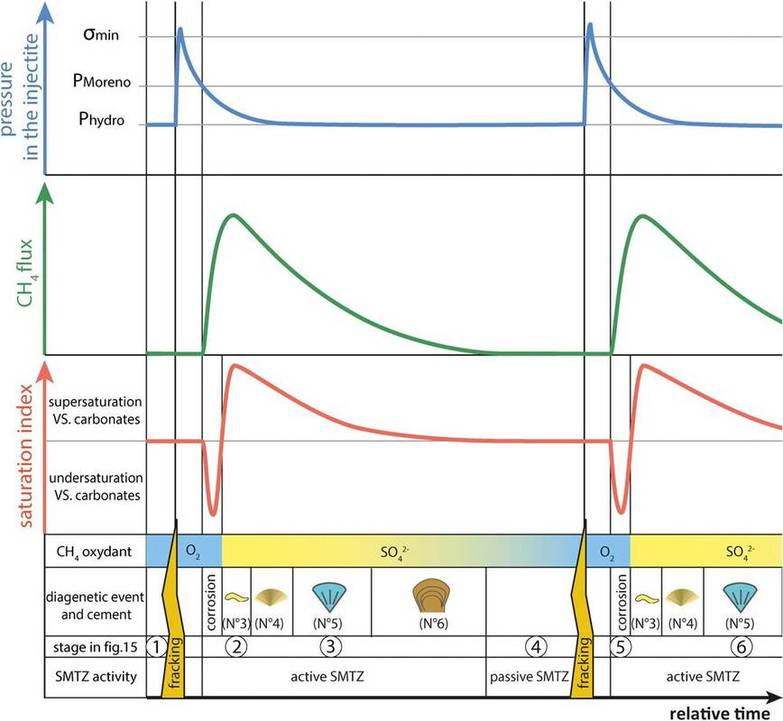
Figure 14. Relation between evolution of pressure in the injectite network, flux of methane, and precipitation of seep carbonates. Here
smin is the minimal stress, the critical value necessary to open a fracture; P Moreno is the pore pressure in the Moreno Formation; and P hydro is
the hydrostatic pressure. SMTZ = sulfate–methane transition zone.
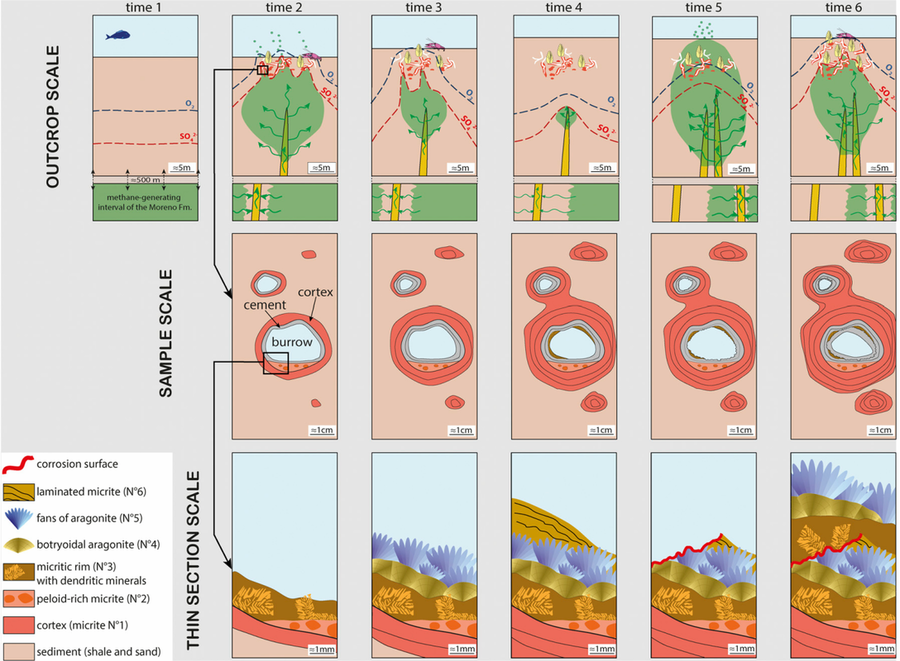
Figure 15. Evolution of methane seepage flux and seep carbonate precipitation through time from outcrop (meters) to thin-section scale (millimeters). Time 1: Initial state of the sediment, before injectite propagation. Burrows are absent. Time 2: After the rapid injectite propagation and drop of pressure of the injectite network to the hydrostatic regime (below the pressure of the Moreno shale), methane is expelled out of the shale and rises through the network up to the surface. The high methane fl ux pushes the sulfate–methane transition zone (SMTZ) upward. Simultaneously, chemosynthetic organisms settle and thrive in this methane-rich environment, burrowing and producing pellets. The intense anaerobic oxidation of methane triggers the precipitation of dendritic minerals while methane diffusion from the burrows to the surrounding sediment initiates the precipitation of the cortex. Time 3: The Moreno shale is progressively depleted in gas, and the flux of methane in the injectites reduces. Consequently, the SMTZ moves back downward, and the elementary sequence (ES) precipitates. Time 4: Once the gas-charged shale surrounding the injectite network is significantly depleted, the upward flux of methane deactivates, and diagenetic interfaces move back close to their original position. Time 5: Reactivation of the injectite network in undepleted sections of the Moreno Formation (Fm.) triggers a new phase of gas migration. Because of the sudden and intense rising flux of methane, gas propagates up to oxic sediment and aerobic oxidation of methane takes place, thus promoting carbonate dissolution. Time 6: A new cycle begins: a new ES precipitates while the shale of the Moreno Fm. depletes.
Acknowledgments
- We thank Total Exploration and Production for the financing of Jean-Philippe Blouet, for granting permission to publish this research, and for many insightful discussions, in particular with geoscientists of the sedimentology and geochemistry research teams.
- The field campaign in 2013 was greatly facilitated by Ivano Aiello, who granted access to the Moss Landing Marine Laboratories, and Hilde Schwartz is acknowledged for providing access to the library of the University of Santa Cruz.
- Both Hilde and Ivano greatly helped to guide the early fi eld reconnaissance.
- Sutieng Ho is greatly thanked for assisting the completion of this manuscript and for her useful advice and stimulating discussions of the work. We thank Kristin and Everett Meagher Robinson for their warm welcome in California.
- We are grateful to Giovanni Aloisi, who offered fruitful insights into the subject in its early stages.
- Thin Section Lab and its personnel are thanked for providing access to their facilities.
- We are grateful to Robin Fentimen for his correction of the English language.
- Reviews of the original manuscript by Martin Hovland and an anonymous reviewer were constructive and beneficial.

